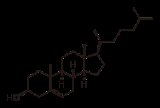
Cholesterol
Overview
Cholesterol is a complex isoprenoid. Specifically, it is a waxy steroid
of fat that is produced in the liver or intestines. It is used to produce hormones and cell membranes and is transported in the blood plasma
of all mammal
s. It is an essential structural component of mammalian cell membranes and is required to establish proper membrane permeability and fluidity
. In addition, cholesterol is an important component for the manufacture
of bile acid
s, steroid hormone
s, and vitamin D
.
Steroid
A steroid is a type of organic compound that contains a characteristic arrangement of four cycloalkane rings that are joined to each other. Examples of steroids include the dietary fat cholesterol, the sex hormones estradiol and testosterone, and the anti-inflammatory drug dexamethasone.The core...
of fat that is produced in the liver or intestines. It is used to produce hormones and cell membranes and is transported in the blood plasma
Blood plasma
Blood plasma is the straw-colored liquid component of blood in which the blood cells in whole blood are normally suspended. It makes up about 55% of the total blood volume. It is the intravascular fluid part of extracellular fluid...
of all mammal
Mammal
Mammals are members of a class of air-breathing vertebrate animals characterised by the possession of endothermy, hair, three middle ear bones, and mammary glands functional in mothers with young...
s. It is an essential structural component of mammalian cell membranes and is required to establish proper membrane permeability and fluidity
Membrane fluidity
In biology, the membrane fluidity refers to the viscosity of the lipid bilayer of a cell membrane.The membrane phospholipids incorporate fatty acids of varying length and saturation...
. In addition, cholesterol is an important component for the manufacture
Biosynthesis
Biosynthesis is an enzyme-catalyzed process in cells of living organisms by which substrates are converted to more complex products. The biosynthesis process often consists of several enzymatic steps in which the product of one step is used as substrate in the following step...
of bile acid
Bile acid
Bile acids are steroid acids found predominantly in the bile of mammals. Bile salts are bile acids compounded with a cation, usually sodium. In humans, the salts of taurocholic acid and glycocholic acid represent approximately eighty percent of all bile salts. The two major bile acids are cholic...
s, steroid hormone
Steroid hormone
A steroid hormone is a steroid that acts as a hormone. Steroid hormones can be grouped into five groups by the receptors to which they bind: glucocorticoids, mineralocorticoids, androgens, estrogens, and progestogens...
s, and vitamin D
Vitamin D
Vitamin D is a group of fat-soluble secosteroids. In humans, vitamin D is unique both because it functions as a prohormone and because the body can synthesize it when sun exposure is adequate ....
.

